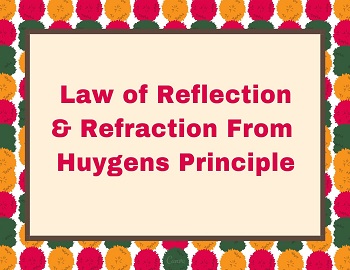Table of Contents
What is Huygens Principle?
In 1678, Huygen proposed that light travels in the form of waves. These waves after emerging from the light source travels in all directions with the speed of light. Huygen gave a simple geometrical procedure for determining the propagation of a wavefront.
According to the Huygens Principle-
- Every point on the given wavefront acts as a source of new wavelets, called as secondary wavelets. The velocity of secondary wavelets is the same as that of the Primary wavefront and is equal to the velocity of light (c).
- A tangent or envelope to the secondary wavelets in the forward direction at any instant gives us the position of a secondary wavefront at that instant.
- In a homogeneous medium, the wavefront is always normal to the direction of propagation of waves.
Let AB represents a section of the wavefront at any instant ‘t’. To find the wavefront at any instant t + Δt, proceed as follows-

- At several points on AB draw circles of radii νΔt, to represent the section of secondary spherical wavelets, where ν is the speed of the wave in a given medium.
- Draw a common tangent CD, and C’D’, these represent the sections of the envelopes of the wavelets.
- If the source lies towards the left, then CD is the forward envelope and gives the new wavefront. If the source is towards the right then C’D’ is the new wavefront (curvature will also be opposite). Kirchhoff explained mathematically the absence of back-wave i.e., wavefronts do not proceed towards the source but always away from it.
Law of Reflection From Huygens Principle or Reflection From Wave theory:
The laws of reflection are-
- The incident ray, reflected ray and normal at the point of incidence lie in the same plane. So it is to be proved that reflected ray lies in the plane defined by incident ray and normal at the point of incidence.
- The angle of incidence (∠i) is always equal to the angle of reflection (∠r).

Suppose AB is the plane wavefront incident on the plane mirror M1M2. ∠BAA’ = ∠i, be the angle of incidence. 1, 2, 3 are the incident rays perpendicular to wavefront AB.
According to Huygens Principle, every point on the wavefront AB is the source of secondary wavelets. Suppose, secondary wavelets from point B, reach point A’ in time t, then-
BA’ = c x t
where ‘c’ is the velocity of light in vacuum.
Suppose secondary wavelets from a point A reach point B’ in time t, then-
AB’ = c x t
Join A’ and B’, then A’B’ be the reflected wavefront. 1′, 2′, 3′ be the reflected rays perpendicular to A’B’. Also, ∠B’A’A = ∠r, be the angle for reflection.
From similar triangles AA’B and AA’B’ we have
BA’ = AB’ {Both are equal to c x t)
∠B = ∠B’ {Both are 90}
AA’ = AA’ {Base Common}
Hence, triangles are congruent.
∠i = ∠r
This is the Snell’s Law of reflection.
Law of Refraction From Huygens Principle or Refraction From Wave theory:
The laws of refraction are-
- The refracted ray lies in the plane which contains the incident ray and normal at the point of incidence.
- The sine of angle of incidence bears a constant ratio with the sine of angle of refraction.

XY is the plane surface that separates a denser medium of refractive index μ from a rarer medium. If C1 be the velocity of light in rarer medium and C2 be the velocity of light in a denser medium, then by definition-
μ = C1/C2 ……………….. (i)
AB is the plane wavefront, incident on XY at ∠BAA’ = ∠i. 1, 2, 3 are the incident rays perpendicular to AB.
According to Huygens Principle, every point on wavefront AB, is the source of secondary wavelets. Suppose, secondary wavelets from point B, reach point A in time t, then-
BA’ = C1 x t ………………(ii)
Where C1 is the velocity of light in rarer medium.
Suppose, secondary wavelets from point A reach point B’ in time t, then-
AB’ = C2 x t ……………..(iii)
From Δ AA’B,
sin i = BA’/AA’ = C1 x t / AA’ ………………(iv)
From From Δ AA’B’,
sin r = AB’/AA’ = C2 x t / AA’ ………………(v)
Divide (iv) by (v)
Sin i/sin r = C1 x t / AA’ / C2 x t / AA’
Sin i/sin r = C1/C2 ……………………(vi)
From (i) and (vi) we have-
Sin i/sin r = μ
This is Snell’s Law of refraction.









Comments (No)